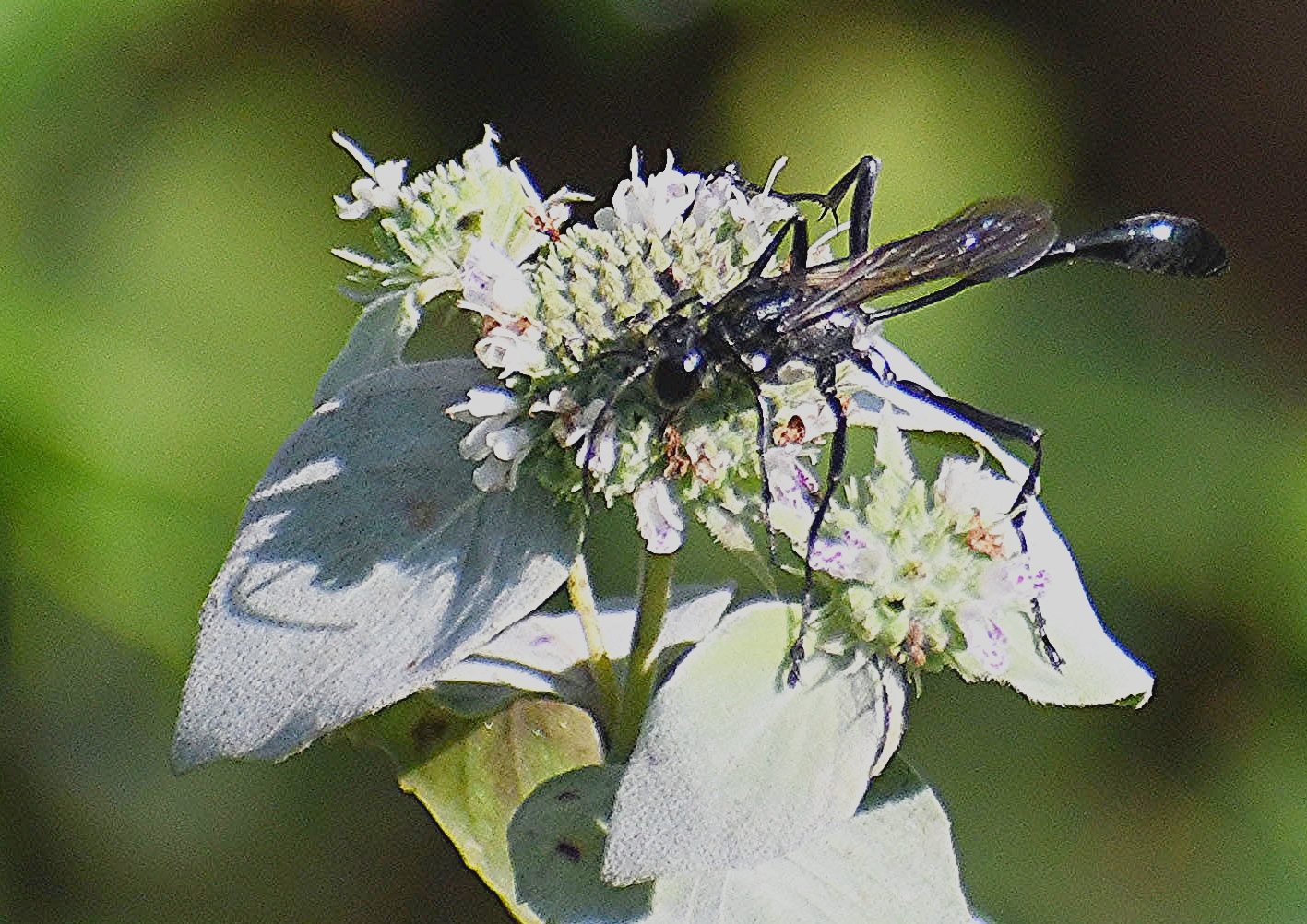
Thread-waisted wasp feeding on nector on a mountain mint blossom (Terry W. Johnson)
By Terry W. Johnson
When we think about pollinators, creatures such as hummingbirds, butterflies and honeybees immediately come to mind. However, the truth of the matter is there is a large suite of other pollinators that are also hard at work pollinating flowering plants. The list of these critters includes the likes of native bees, hoverflies, beetles, flies, moths and wasps.
One of the latter is the thread-waisted wasp. These insects are actually some of the most underappreciated pollinators flying around the Georgia landscape. The fact that these wasps also help control insect pests qualifies them as being one of our most beneficial insects.
Although you may not have ever heard of the thread-wasted wasp, I am sure you have seen them. There are more than 125 species of thread-waisted wasps in North America. Individual species are even difficult for entomologists to distinguish from one another. However, they all feature a long, extremely skinny stalk-like abdomen. This abdomen is so thin it is hard to imagine that any liquid can pass through it. According to some experts, the only advantage of having such a slender abdomen is that it enables the wasp to more easily maneuver its body into position to lay eggs and sting would-be predators.
Most of the thread-waisted wasps I see in my yard range in size from a little less than a half-inch long to a bit more than an inch. Some are entirely black while others have a burnt orange band or black patches.
Unlike many wasps, these wasps are solitary. However, you often see males and females accompanying one another when they are preparing to mate.
Adults feed on both nectar and pollen; from time to time, some even eat small insects. They also parasitize other insects and even spiders. The size of the wasp dictates the size of its prey. Consequently, some will parasitize large prey such as caterpillars, grasshoppers and cockroaches while others attack insects as small as aphids.
Female thread-waisted wasps are constantly on the lookout for prey. When a female spots something like a caterpillar, it grabs it just behind its head. Once it has the hapless animals in its powerful jaws, it injects it with a chemical that paralyzes the victim. The wasp then uses its long legs to haul the prey back to its nest.
Nests vary from species to species; however, most are nothing more than a tunnel excavated in the ground. Others lay their eggs in the nests of other insects. Some thread-waisted wasps lay a single egg beside their paralyzed prey. Others place several eggs alongside the critters they bring to their nests. Once a female has laid her egg or eggs and stocked her larder with live food, she plugs and camouflages the entrance to the nest with bits of twigs, leaves, small stones and even dirt.
After the nest is sealed, she does not defend it from predators. In fact, she never returns to it. Once the eggs hatch, the young begin feasting on the very much alive insects or spiders their mother left for them. Eventually they develop into winged adults and leave the nest.
Thread-waisted wasps have a propensity for frequenting plants that bear white and yellow blooms that are not funnel-shaped. They much prefer to feed at blossoms that harbor nectar that is easy to reach. Some of the plants these valuable insects favor include Queen Anne’s lace, asters, mountain mint and goldenrod. When the mountain mint was blooming in my yard a few weeks ago, thread-waisted wasps visited it far more than any other plant.
At this time of the year, goldenrod is in full bloom, blanketing fields and roadsides with sprays of blossoms. If you walk up to the edge of a field or patch of goldenrod, you will likely see lots of thread-waisted wasps hard at work. This is because thread-waisted wasps are one of goldenrod’s most common pollinators.
While many wasps are sometimes aggressive, that’s not the case with thread-waisted wasps. They rarely sting humans. However, they will sting, especially when provoked. Fortunately, although such stings do hurt, they typically only pose a threat to those among us who are allergic to bee stings.
Hopefully, I have convinced you that the thread-waisted wasp is one of the most undervalued pollinators and insect predators living in our backyards and beyond. On top of that, it is a truly fascinating and odd-looking resident – just one more example of the seemingly endless variety of organisms that are living just outside our backdoor.
Terry W. Johnson is a retired Nongame program manager with the Wildlife Resources Division and executive director of The Environmental Resources Network, or TERN, friends group of the division’s Nongame Conservation Section. (Permission is required to reprint this column.) Learn more about TERN, see previous “Out My Backdoor” columns, read Terry’s Backyard Wildlife Connection blog and check out his latest book, “A Journey of Discovery: Monroe County Outdoors.”




















